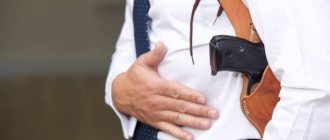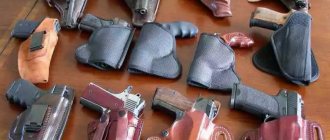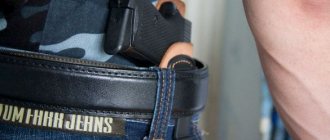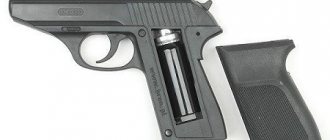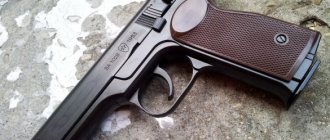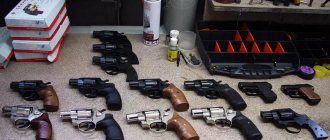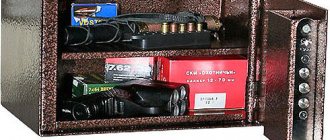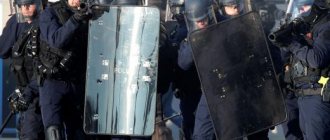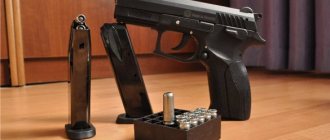The Code of Administrative Offenses and the Criminal Code of the Russian Federation establish liability for illegal possession of weapons. For a person, the difference is colossal. Or administrative punishment. Or a criminal conviction. Therefore, in this publication we will also talk about violation of storage rules, when there is an administrative offense. And about such violations when illegal storage becomes a crime. Rules for storing weapons at home are also posted on the website.
Classification system
Melee weapons can be classified as one or another type, genus, class, subspecies or species, variety in accordance with various grounds:
- According to the production method.
- Device.
- Operating principle.
- Appointment and so on.
The classification system acts as a scientific and theoretical basis for determining the group affiliation of an object. It is considered one of the most significant structural components of forensic science, which studies not only weapons used in committing crimes, but also all its varieties.
General information about storage
Violation of the procedure for storing bladed weapons does not entail the application of legal sanctions. This is due to the fact that there are no strictly legal rules on how to store such products. But the following universal rules can be identified:
- mandatory presence of covers;
- insulate the product out of the reach of children and third parties (it is better to use a safe or a lockable cabinet).
But they can be punished for illegally carrying or manufacturing bladed weapons. You can authorize the transportation of such weapons:
- persons who require knives in the performance of official duties;
- if the products are necessary for use in hunting, but only during the period of permission to hunt;
- military, if the product is an award or trophy;
- antique items, but only during cultural events;
- as self-defense.
All other cases of exploitation may be subject to legal sanctions.
Important! Not in every case you will need a permit to operate and possess bladed weapons. For example, hunters who have a firearms permit also have access to the sale of knives.
Types according to existing types
Those edged weapons that have no analogues in the classification system, but at the same time possess all its generic properties and characteristics, are called atypical. Usually this is either a completely original design or a disguised device. The latter include, for example, a stiletto handle and a sword cane. Those edged weapons that correspond to historically established models, are adopted by armies, or are traditional for some nation or nationality are called standard.
Definition
In accordance with Russian legislation, edged weapons are intended to hit targets using human muscle power in direct contact with the object. Throwing objects are objects that are used when the target is at a distance. In this case, such a device receives the direction of movement through the application of muscular force or through a mechanical device. Certified products for industrial and household purposes, as well as sports equipment that are structurally similar to them, are not included in the category of edged weapons.
Main features
In accordance with the Federal Law, questions regarding the classification of any specific item as a bladed weapon are resolved solely on the basis of the results of forensic examination or certification. In doing so, specialists are guided by regulations and relevant requirements. In particular, the classification of an item as a bladed weapon is influenced by:
- Butt thickness.
- Blade length.
- Handle design.
- Blade hardness and so on.
In modern practice, the knife manufacturer or their seller certifies the products in a specialized center. The latter, in turn, must be accredited and registered in the register of relevant authorities. The seller or manufacturer receives a certificate according to which the knife belongs to the household category (sports, tourism, kitchen) or to a weapon. You can receive an “information sheet” upon purchase. It contains a description of the knife itself, an expert opinion, date and number, as well as the coordinates of the competent authority.
Is there criminal liability for possession of bladed weapons?
It cannot be said unequivocally that owners of bladed weapons are protected from criminal attacks, and why they carry knives and stilettos, in principle. In any case, you need to know whether your favorite pocket knife is a bladed weapon. To do this, we suggest that you familiarize yourself with the main signs by which you can distinguish a table knife from a prohibited weapon.
As it becomes clear from the above, there are a huge number of products that fall under the definition of edged weapons. At the same time, flails, brass knuckles, shurikens and boomerangs are completely prohibited. All of the listed products have an impact-crushing nature or are designed to be thrown, thus they pose an increased threat to society.
08 Aug 2021 semeiadvo 149
Share this post
- Related Posts
- Social payments Chernobyl January 2021 when will it be
- Living wage for a pensioner in the Kirov region for 2021
- Luzhkov payments 2021 at the birth of a child
- Apartment donation agreement between close relatives 2021 template
Typology
In accordance with the law, depending on the purposes of use by certain entities, as well as on the basis of general parameters and characteristics, all weapons are divided into:
- Official. It is intended for use by various government officials and legal employees. persons who have the right to store, use and bear arms.
- Civil. It is intended for use by Russian citizens for self-defense, hunting or sports.
- Combat cold and hand rifle. It is used to solve operational and military tasks and is adopted by army organizations.
Melee weapons are not classified separately. However, the regulations indicate that:
- Bladed edged weapons can be considered sporting and hunting.
- Throwing devices are distinguished as an independent subtype.
- Bladed edged weapons can be worn together with Cossack uniforms and national costumes of the peoples of Russia. Their attributes are established by the Government.
- Leaders of paramilitary state organizations can accept edged weapons. The admission procedure is established by the Russian Government.
Rules for storing weapons
When purchasing edged weapons, you must provide permission to store them. Without a license, a store employee has no right to sell weapons. In turn, the seller must provide documents for the goods after purchase, so that problems with the law do not arise in the future.
Note!
Since the license is valid for 5 years, upon expiration it must be changed or renewed. The law prohibits the purchase or possession of weapons if the license has expired.
Any weapon at home should be stored in a metal safe. Only the owner should have access to the safe.
It is prohibited to carry bladed weapons for self-defense, as well as during rallies, processions and demonstrations. You cannot send bladed weapons by mail. Athletes may use weapons within the sporting venue. A fencer may only use an epee during training or competition. Military and law enforcement officers are allowed to carry weapons only while on duty.
Other classification
In accordance with the production method, edged weapons are divided into:
- Factory. By design, such products comply with standards and technical specifications, and also have markings.
- Artisanal. Such weapons are made to certain standards by master gunsmiths. Products may have a special mark.
- Homemade. Such weapons are made by people who do not have the appropriate professional skills.
- Remade. Such weapons include products processed by removing or adding certain elements.
Depending on the place of manufacture, the weapon can be:
- Domestic.
- To foreigners.
Depending on the principle of operation, weapons are distinguished:
- Chopping (swords, sabers).
- Throwing (kunai, shuriken, dart, spear).
- Piercing-cutting (broadsword, scimitar).
- Impact-crushing (brass knuckles, flail, club, club).
- Piercing (needle bayonet, stiletto, dagger, rapier, pike).
- Combined action.
- Piercing and cutting (bayonet, knife, dagger, sword).
Depending on the features of the structural device, there are:
- Non-blade.
- Blade.
According to certain requirements, the following are distinguished:
- Standard.
- Non-standard.
Depending on the design features of the blade, there are weapons:
- Double-edged.
- Single blade.
Restrictions for civil circulation
In accordance with the adopted legislation, the following manipulations are prohibited on the territory of Russia:
1. Trafficking in certain types of bladed weapons:
- Boomerangs, shurikens, brass knuckles, flails and other special devices with throwing and impact-crushing action. The exception is sports equipment.
- Knives and bladed weapons, the blades and blades of which are either automatically removed by pressing a lever or button from the handle and then fixed by them, or extended through the action of accelerated movement or gravity and secured if their length is more than 90 cm.
2. Storage and carrying of bladed and throwing bladed and throwing weapons for sporting purposes. An exception is the use of bows and crossbows for the purpose of carrying out preventive and research work that involves the injection and immobilization of fauna objects.
3. Shipping.
4. Carrying of bladed weapons by citizens during public mass events. These include, in particular, picketing, demonstrations, street processions, rallies, etc.
5. Carrying bladed weapons for self-defense. The exception is the transportation (carriage) of devices.
In the last two cases, we mean exclusively edged weapons, but not objects similar to them. Such devices, for example, include penknives and cutlery. For civil transactions, it is necessary to obtain appropriate documents, depending on the purpose of use. This could be a license to carry bladed weapons, a certificate. Atypical devices produced by handicraft methods without complying with standard requirements and technical conditions are prohibited for circulation.
Rules for carrying edged weapons
In Russia, the following categories of persons are allowed to carry edged weapons:
- professional athletes, if it is related to the sport;
- hunters, reindeer herders, rangers;
- law enforcement officers, if they are on duty;
- military personnel can carry not only service weapons, but also award/trophy weapons if they have documents with them;
- forwarding security guards who transport or protect inventory items;
- employees of the Russian Academy of Sciences for certain work and research;
- collectors - professional antique dealers.
Note!
Ordinary citizens can also carry bladed weapons, but to do this they need to obtain a special license.
It is also allowed to buy blades and sabers if they complement the national costume. You can only carry such a weapon during a concert, award ceremony, or national costume parade.
Acquisition
Citizens of the Russian Federation who have reached the age of 18 have the right to buy edged weapons. In this case, you must obtain the appropriate document to purchase products. Typically this is a license. It is allowed to purchase products for self-defense, hunting, and sports. The document gives the right to purchase and carry bladed and hunting bladed weapons with national costumes or Cossack uniforms. You can obtain the necessary paper for a specific type of product at your place of residence at the police department.
Permit Training
First of all, it is important that a person has a conscious desire to receive this type of modern weapon, and it is also important to understand what kind of responsibility is assigned to him. In addition, you will need to do the following:
- Training required;
- It is important to obtain special permission to purchase weapons;
- A pistol is being purchased;
- Permission to use weapons is obtained.
You can undergo training in special organizations where training courses are organized. They are designed for this purpose and certified for this purpose. After completing the training, you will receive a document confirming completion of qualified training and passing the exam.
Administrative responsibility
For carrying a bladed weapon without the appropriate documents or violating other requirements, appropriate measures may be taken against a citizen. They are quite clearly stated in the Administrative Code of Offences. The civil circulation of the products in question is regulated by the Law on the carrying of bladed weapons, their acquisition, transportation, use, exhibition, sale, and production. The regulatory act also establishes the procedure for recording and destroying items of this category.
Punishment for carrying bladed weapons, violating registration deadlines and other requirements related to their civil circulation is, as a rule, a fine. The regulation of March 7, 2013 limits manipulations with products of this category. Paragraph 4, which contains the corresponding article, for carrying bladed weapons without documents, as well as other unlawful actions, provides for the imposition of penalties on the violator. Its size ranges from 500 to 2000 rubles. Administrative liability for carrying bladed weapons can be expressed in deprivation of the right to do anything with devices for a period of 6 months to a year.
Illegal carrying of weapons
The law prohibits carrying bladed weapons unless the owner has a license to do so.
The permit will not be issued if:
- the applicant is under 18 years of age;
- the person does not have a medical certificate allowing him to carry a weapon;
- the person has an outstanding criminal record;
- the citizen was brought to administrative responsibility more than twice a year;
- the applicant does not have a permanent place of residence;
- the citizen received punishment for using or distributing drugs;
- the court prohibited the citizen from keeping any weapons.
What products can I purchase?
A citizen who has a permit to carry and store firearms can also purchase bladed weapons. At the same time, a corresponding mark is made on his ticket. In this case, there is no additional need to obtain a permit to carry bladed weapons. It is used as existing paper. As mentioned above, carrying bladed weapons is allowed with a Cossack uniform or national costume. For this you need the appropriate paper. The document is a license. It gives the right not only to purchase products. The document also acts as a permit to carry bladed weapons as an attribute.
Peculiarities of carrying knives on the territory of the Russian Federation
On the territory of Russia, you can carry knives anywhere and any kind, with the exception of knives related to edged weapons. How you can carry edged weapons is described in the Weapons Law.
You can only carry edged weapons with a Cossack uniform and national costumes, but you must also have the appropriate documents for this. Hunting edged weapons, if you have permits, can only be carried in hunting grounds; in other cases, only their transportation is permitted.
Separate acts and orders may prohibit the carrying of knives (piercing and cutting objects) in places where any organized events are held or at sensitive facilities.
If you have a knife while attending such an event, the organizers have the right not to let you into it or ask you to leave this place, or hand over the knife for safekeeping.
You do not have the right to confiscate or take away your property, which is a knife.
If you were stopped by a police officer or the National Guard and decided legally search your belongings or search your property, and found a knife on you, then several options are possible:
- he can confiscate it before the end of the investigative actions, and then return it; if he does not return it, then this is an official crime for which he will have to bear responsibility;
- if he believes that this is a bladed weapon, he must send it for examination, which will decide whether it is one or not.
If the examination recognizes your knife as a bladed weapon, and you do not have permits to carry it, then you face punishment under Article 20.8 of the Code of Administrative Offenses of the Russian Federation, Part 4 Violation of the rules for storing, carrying or destroying weapons and ammunition by citizens.
A fine of 500 to 2000 rubles; if you have permission to carry and store weapons, then temporary deprivation of this right is possible.
Please note that the search, examination and seizure must be carried out within the framework of current legislation and recorded in appropriate protocols , which can subsequently be appealed. Do not forget about Article 51 of the Constitution and the right to the assistance of a lawyer or defender. payment for the services of a defender or lawyer through the court from the organization that carried out unlawful actions against you, if they were truly unlawful.
Two inconspicuous and small knives on top are edged weapons. The second knife from the top in some countries is considered a military weapon and is used in the armed forces. At the same time, large and no less durable folding knives from below are not edged weapons and they can be carried freely throughout the country.
Carrying hunting knives is only possible in hunting areas if you have a permit for a hunting weapon and a hunting license. In other places, if you have these documents, you can transport it.
Important: violation of the rules for transporting and carrying hunting knives is punishable under Article 20.8 Part 4 of the Code of Administrative Offenses of the Russian Federation, which, in addition to a fine, provides for temporary deprivation of the right to store and carry weapons, so be careful if you decide to take a hunting knife fishing and decide to hang it on your belt, and not left in the sheath in the backpack.
There is no need to carry or keep any certificates stating that a knife is not a bladed weapon, no law forces you to do this, you are not obliged to present these papers to police officers or other authorities, and they are not documents for them. If a knife was confiscated from you on suspicion of being a bladed weapon, then the document will be the result of a forensic examination, and not your certificate.
Knives on public transport
Traveling with a knife that is not a bladed weapon in the subway, trains and other types of transport, with the exception of an airplane, is permitted freely.
If you are harassed by security officers (usually in the subway or at train stations), calmly write a complaint against them to this organization, to the organization that issued them a license for security activities and to the prosecutor's office for exceeding their official duties and illegally restricting your rights.
If the knife is a bladed weapon, you only have the right to transport it in any type of public transport if you have the appropriate permit; for hunting knives, this is a hunting ticket and a permit to store and carry firearms.
In this case, you are required to present these documents only to the police officer, and not to security officers.
Do not forget about your obligation to prevent access to weapons by unauthorized persons; this also applies to bladed weapons, so if you let them go on the X-ray tape without being seen, you could theoretically incur administrative liability.
To avoid this situation, ask to invite a police officer, show him your permits and go freely to the station or metro.
Knives on the plane
When transporting bladed weapons by plane, it is better to first call the airport security service and find out how it is easier for you to transport your hunting knife. Most likely, you will be asked to check it either as luggage or to security, who will load it onto the plane, and you will receive it upon arrival at your destination.
When handing over or transporting bladed weapons in your luggage, do not forget that you are losing control over them and giving access to the weapon to unauthorized persons, for which you will face liability. It is better to hand it over to airport security and receive it from them upon arrival at your destination.
Regular knives are carried in checked luggage. You will not be allowed on board a plane with a knife, and this is legal.
Provisions of the Criminal Code
Previously, violations of the established procedure were regulated by the Criminal Code of the Russian Federation. Carrying bladed weapons without the appropriate papers was considered a criminal offense. Today, other regulations are in force. Illegal carrying of bladed weapons is considered an administrative offense. However, regulations have not disappeared from the Criminal Code. Before they were introduced for carrying bladed weapons, the Criminal Code established mandatory correctional labor for 180-200 hours, 1-2 years.
Arrest for 3-6 months or imprisonment for a period of up to 2 years was also provided. In the latter case, for carrying knives, Article 222 of the Criminal Code (Part 4) provided for a fine of 200 times the minimum wage or equal to the wages or other income of the offender. Today the Criminal Code regulates only illegal sales. The punishment for selling cold steel, throwing weapons, and gas weapons is mandatory correctional labor for 180-200 hours or 1-2 years. As in the previous case, arrest and imprisonment with or without a fine are provided. Criminal penalties may also follow for the illegal manufacture of weapons. In this case, compulsory correctional labor, arrest, and imprisonment with or without penalties may also be imposed.
Illegal possession of traumatic weapons: article of the Criminal Code of the Russian Federation for carrying without a license and permission
Every year the number of civilians who purchase traumatic guns increases.
Having decided to take such a serious step, everyone must understand that there are certain requirements for storing and carrying traumatic weapons and firearms.
If you fail to comply with these standards, you may face criminal liability. Article 222 of the Criminal Code of the Russian Federation provides for punishment for illegal possession of traumatic weapons.
Corpus delicti
Very few people understand the difference between a firearm and a traumatic gun, although in fact it is huge. The Criminal Code does not have a clear definition of a traumatic gun.
There is only an indication that this is a short-barreled or barrelless weapon, the purpose of which is to hit a living creature.
The method of using this specimen is to throw a cartridge case with a traumatic substance.
The legislator defines certain technical characteristics that make it possible to classify a means of self-defense as a traumatic type and assign liability for the illegal storage of traumatic weapons. These include:
- the charge should not exceed 10 rounds;
- the energy output at the moment of the shot should not be more than 91 Joule;
- Only cartridges containing a traumatic substance can be used for charging.
In most cases, a traumatic gun is purchased for self-defense; accordingly, it is legal and is classified as a type of civilian weapon.
The Criminal Code describes illegal possession of weapons as a serious crime entailing punishment. The object of the crime is public safety. The subject of the violation can be a person over 16 years of age if he has a weapon without a license.
The subjective side is expressed in direct intent (to store or secretly use). The objective side of the violation of illegal possession of weapons. It should be noted that the illegal actions of a person may contain signs of both an administrative offense and a criminal one.
The judge, as well as the investigative body, will have to determine the characteristics of the gun and the identity of the culprit; this determines under which code the offender will be held accountable.
What is illegal storage
Illegal possession of traumatic weapons is determined by the presence of a license - a document that confirms the right of a particular person to use a gun.
A license is issued only to mentally healthy people who provide the necessary package of documents. Before obtaining a license, a person must also provide a special storage place and equip a so-called safe.
This safe should limit access to the traumatic pistol for children and third parties.
Often, law enforcement officers observe a situation where, having received a license for a gun and having purchased it, people put it up for sale on the Internet.
At the same time, they give the traumatic pistol to others for a certain amount, regardless of whether they have a license. By purchasing a gun this way, you may find yourself under the law and liable. In order not to answer under Art.
First developments
Various types of bladed weapons were manufactured in the English Special Operations Executive and the American Office of Strategic Services during the Second World War. The products consisted of various items. Knives and daggers were intended to be worn behind the lapels of jackets and jackets; stilettos looked like hat pins. Often, special smaller modifications of leather sheaths were used for knives. Thanks to the special design, the item could be attached to different parts of the body.
Blades for self-defense
In the 70s of the previous century, ordinary citizens were forced to look for means to ensure their safety while on city streets. This was due to a sharp increase in crime. Over the next decade, the volume of manufactured bladed weapons for concealed carry increased significantly. Initially, manufacturers took as a basis the developments of the above USS and USO. Subsequent improvements in the designs of bladed weapons for concealed carry followed the development and implementation of new devices, reducing the size of the blade itself while simultaneously increasing its cutting or piercing properties. Products disguised as ordinary objects were also produced.
Special devices
Concealed carry was achieved through belt systems similar to the shoulder straps used for firearms. They made it possible to carry knives of regular (standard) sizes unnoticed by others under outer clothing (jacket or blazer). The production of systems was carried out for a specific model of the product or its specific position (handle down or up, on the back, on the side, and so on). The use of a new type of plastic as a consumable material in the production of covers for knives with a fixed blade or for folding objects was revolutionary. In such a sheath, thanks to its elasticity, the weapon was securely held in any position, as well as quick removal. Manufacturers began to produce sets of knives with carrying systems that made it possible to fix the item in the way the owner preferred.
Transportation procedure
To date, regulations have not clearly established the rules for carrying bladed weapons. However, there are a number of prohibitions. So, in the Law “On Weapons”, in Art. 6, it is determined that wearing products from this category as a means of self-defense is not allowed. In addition, there is an obligation to have accompanying documents. In particular, the owner of a bladed weapon should have a citizen’s passport, hunting or military ID, service ID and other documents confirming his identity. In addition, paper is needed for the product itself.
It is a license issued by the Internal Affairs Authority at the place of residence. There is an established opinion regarding the correct transportation of products in this category. And many police officers adhere to it. Thus, it is considered correct to carry bladed weapons along with accompanying documents in a bag or backpack. At the same time, of course, when detained by police, one can try to explain that the knife in the case on the belt is not a means of self-defense and is hanging solely for convenience. Moreover, the law does not stipulate where exactly it should be kept during transportation. Of course, you should have the relevant documents with you. Otherwise, it will be difficult to prove anything.
What is considered a bladed weapon?
The Federal Law “On Weapons” provides a definition of this concept. A bladed weapon is an object designed to hit a living target using human muscular strength in contact with the victim of the attack. These are knives, daggers, brass knuckles, sabers.
There are several groups of edged weapons:
- piercing;
- chopping;
- piercing-cutting;
- piercing-cutting;
- impact-crushing;
- throwing;
- combined action: karambit, shuangou.
The following characteristics are characteristic of edged weapons:
You are advised by the best qualified lawyers
Free: Our lawyers provide free initial consultation on any legal issues. 90% of cases are resolved with one free consultation.
24/7: real estate via online chat, or call the hotline 24 hours a day, 7 days a week
- blade length is more than 90 mm;
- blade thicker than 2.4 mm;
- the angle of convergence of the butt and blade is less than 70 degrees;
- blade roll no more than 9 mm;
- minimum steel hardness - 25 Rockwell;
- the blade can penetrate to a depth of more than 20 mm;
- the holder has a finger stop;
- the tip of the blade should be comfortable for striking if the weapon has a stopper.
Only an expert can give an opinion on whether a certain item is a bladed weapon. Experts do not consider weapons that are intended for use in everyday life - garden knives, kitchen knives, manicure scissors.

